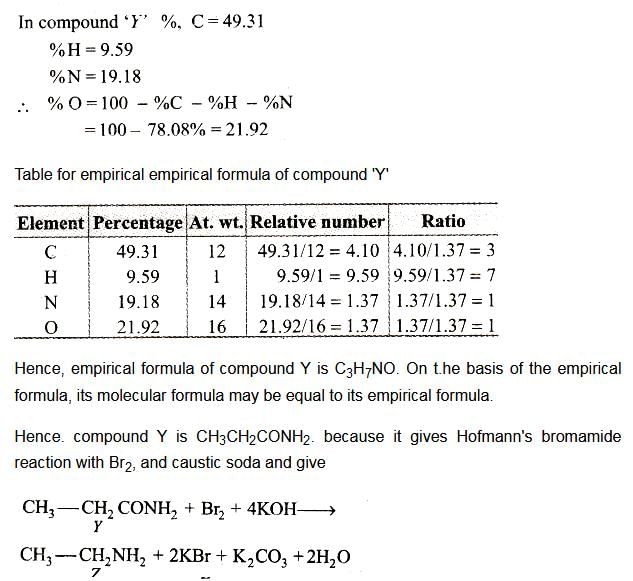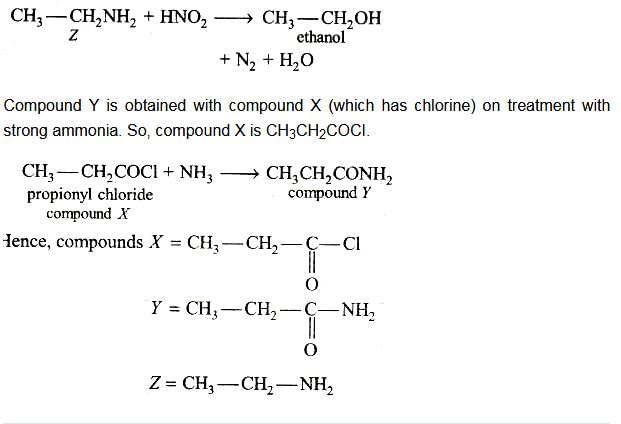Chemistry Exam > Chemistry Questions > Compound 'X' containing chlorine on t...
Start Learning for Free
Compound 'X' containing chlorine on treatment with strong ammonia gives a solid 'Y' which is free from chlorine. 'Y' was analyzed and found to contain 44.31% C, 9.59% H and 19.50% N. ‘X’ reacts with Br2 and caustic soda to give a basic compound 'Z'. 'Z' give ethanol on treatment with HNO2. Find the total number of carbon atom(s) present in the empirical formula of 'Y':
Correct answer is '3'. Can you explain this answer?
| FREE This question is part of | Download PDF Attempt this Test |
Verified Answer
Compound 'X' containing chlorine on treatment with strong ammo...
Ans.


Most Upvoted Answer
Compound 'X' containing chlorine on treatment with strong ammo...
The balanced chemical equation for the reaction between compound X and strong ammonia is:
X + 2NH3 → Y + NH4Cl
From the equation, we can see that Y is formed by the replacement of chlorine in X with NH3, which is why Y is free from chlorine.
To determine the molecular formula of Y, we need to calculate its empirical formula first. We assume that we have 100 g of Y, which means we have 44.31 g of C, 9.59 g of H, and 19.50 g of N.
The number of moles of each element can be calculated as follows:
moles of C = 44.31 g / 12.01 g/mol = 3.69 mol
moles of H = 9.59 g / 1.01 g/mol = 9.50 mol
moles of N = 19.50 g / 14.01 g/mol = 1.39 mol
The smallest mole value is 1.39 mol, which means the empirical formula of Y will have a ratio of atoms close to C3H10N2.
To find the molecular formula, we need to know the molar mass of Y. We can calculate it as follows:
molar mass of Y = (3.69 x 12.01 g/mol) + (9.50 x 1.01 g/mol) + (1.39 x 14.01 g/mol) = 74.09 g/mol
The molecular formula of Y can then be calculated by dividing its molar mass by the molar mass of its empirical formula (C3H10N2):
n = molar mass of Y / molar mass of C3H10N2
n = 74.09 g/mol / 74.13 g/mol ≈ 1
Therefore, the molecular formula of Y is C3H10N2.
In summary, compound X containing chlorine reacts with strong ammonia to form Y, which is free from chlorine and has a molecular formula of C3H10N2.
X + 2NH3 → Y + NH4Cl
From the equation, we can see that Y is formed by the replacement of chlorine in X with NH3, which is why Y is free from chlorine.
To determine the molecular formula of Y, we need to calculate its empirical formula first. We assume that we have 100 g of Y, which means we have 44.31 g of C, 9.59 g of H, and 19.50 g of N.
The number of moles of each element can be calculated as follows:
moles of C = 44.31 g / 12.01 g/mol = 3.69 mol
moles of H = 9.59 g / 1.01 g/mol = 9.50 mol
moles of N = 19.50 g / 14.01 g/mol = 1.39 mol
The smallest mole value is 1.39 mol, which means the empirical formula of Y will have a ratio of atoms close to C3H10N2.
To find the molecular formula, we need to know the molar mass of Y. We can calculate it as follows:
molar mass of Y = (3.69 x 12.01 g/mol) + (9.50 x 1.01 g/mol) + (1.39 x 14.01 g/mol) = 74.09 g/mol
The molecular formula of Y can then be calculated by dividing its molar mass by the molar mass of its empirical formula (C3H10N2):
n = molar mass of Y / molar mass of C3H10N2
n = 74.09 g/mol / 74.13 g/mol ≈ 1
Therefore, the molecular formula of Y is C3H10N2.
In summary, compound X containing chlorine reacts with strong ammonia to form Y, which is free from chlorine and has a molecular formula of C3H10N2.

|
Explore Courses for Chemistry exam
|

|
Similar Chemistry Doubts
Compound 'X' containing chlorine on treatment with strong ammonia gives a solid 'Y' which is free from chlorine. 'Y' was analyzed and found to contain 44.31% C, 9.59% H and 19.50% N. ‘X’ reacts with Br2 and caustic soda to give a basic compound 'Z'. 'Z' give ethanol on treatment with HNO2. Find the total number of carbon atom(s) present in the empirical formula of 'Y':Correct answer is '3'. Can you explain this answer?
Question Description
Compound 'X' containing chlorine on treatment with strong ammonia gives a solid 'Y' which is free from chlorine. 'Y' was analyzed and found to contain 44.31% C, 9.59% H and 19.50% N. ‘X’ reacts with Br2 and caustic soda to give a basic compound 'Z'. 'Z' give ethanol on treatment with HNO2. Find the total number of carbon atom(s) present in the empirical formula of 'Y':Correct answer is '3'. Can you explain this answer? for Chemistry 2024 is part of Chemistry preparation. The Question and answers have been prepared according to the Chemistry exam syllabus. Information about Compound 'X' containing chlorine on treatment with strong ammonia gives a solid 'Y' which is free from chlorine. 'Y' was analyzed and found to contain 44.31% C, 9.59% H and 19.50% N. ‘X’ reacts with Br2 and caustic soda to give a basic compound 'Z'. 'Z' give ethanol on treatment with HNO2. Find the total number of carbon atom(s) present in the empirical formula of 'Y':Correct answer is '3'. Can you explain this answer? covers all topics & solutions for Chemistry 2024 Exam. Find important definitions, questions, meanings, examples, exercises and tests below for Compound 'X' containing chlorine on treatment with strong ammonia gives a solid 'Y' which is free from chlorine. 'Y' was analyzed and found to contain 44.31% C, 9.59% H and 19.50% N. ‘X’ reacts with Br2 and caustic soda to give a basic compound 'Z'. 'Z' give ethanol on treatment with HNO2. Find the total number of carbon atom(s) present in the empirical formula of 'Y':Correct answer is '3'. Can you explain this answer?.
Compound 'X' containing chlorine on treatment with strong ammonia gives a solid 'Y' which is free from chlorine. 'Y' was analyzed and found to contain 44.31% C, 9.59% H and 19.50% N. ‘X’ reacts with Br2 and caustic soda to give a basic compound 'Z'. 'Z' give ethanol on treatment with HNO2. Find the total number of carbon atom(s) present in the empirical formula of 'Y':Correct answer is '3'. Can you explain this answer? for Chemistry 2024 is part of Chemistry preparation. The Question and answers have been prepared according to the Chemistry exam syllabus. Information about Compound 'X' containing chlorine on treatment with strong ammonia gives a solid 'Y' which is free from chlorine. 'Y' was analyzed and found to contain 44.31% C, 9.59% H and 19.50% N. ‘X’ reacts with Br2 and caustic soda to give a basic compound 'Z'. 'Z' give ethanol on treatment with HNO2. Find the total number of carbon atom(s) present in the empirical formula of 'Y':Correct answer is '3'. Can you explain this answer? covers all topics & solutions for Chemistry 2024 Exam. Find important definitions, questions, meanings, examples, exercises and tests below for Compound 'X' containing chlorine on treatment with strong ammonia gives a solid 'Y' which is free from chlorine. 'Y' was analyzed and found to contain 44.31% C, 9.59% H and 19.50% N. ‘X’ reacts with Br2 and caustic soda to give a basic compound 'Z'. 'Z' give ethanol on treatment with HNO2. Find the total number of carbon atom(s) present in the empirical formula of 'Y':Correct answer is '3'. Can you explain this answer?.
Solutions for Compound 'X' containing chlorine on treatment with strong ammonia gives a solid 'Y' which is free from chlorine. 'Y' was analyzed and found to contain 44.31% C, 9.59% H and 19.50% N. ‘X’ reacts with Br2 and caustic soda to give a basic compound 'Z'. 'Z' give ethanol on treatment with HNO2. Find the total number of carbon atom(s) present in the empirical formula of 'Y':Correct answer is '3'. Can you explain this answer? in English & in Hindi are available as part of our courses for Chemistry.
Download more important topics, notes, lectures and mock test series for Chemistry Exam by signing up for free.
Here you can find the meaning of Compound 'X' containing chlorine on treatment with strong ammonia gives a solid 'Y' which is free from chlorine. 'Y' was analyzed and found to contain 44.31% C, 9.59% H and 19.50% N. ‘X’ reacts with Br2 and caustic soda to give a basic compound 'Z'. 'Z' give ethanol on treatment with HNO2. Find the total number of carbon atom(s) present in the empirical formula of 'Y':Correct answer is '3'. Can you explain this answer? defined & explained in the simplest way possible. Besides giving the explanation of
Compound 'X' containing chlorine on treatment with strong ammonia gives a solid 'Y' which is free from chlorine. 'Y' was analyzed and found to contain 44.31% C, 9.59% H and 19.50% N. ‘X’ reacts with Br2 and caustic soda to give a basic compound 'Z'. 'Z' give ethanol on treatment with HNO2. Find the total number of carbon atom(s) present in the empirical formula of 'Y':Correct answer is '3'. Can you explain this answer?, a detailed solution for Compound 'X' containing chlorine on treatment with strong ammonia gives a solid 'Y' which is free from chlorine. 'Y' was analyzed and found to contain 44.31% C, 9.59% H and 19.50% N. ‘X’ reacts with Br2 and caustic soda to give a basic compound 'Z'. 'Z' give ethanol on treatment with HNO2. Find the total number of carbon atom(s) present in the empirical formula of 'Y':Correct answer is '3'. Can you explain this answer? has been provided alongside types of Compound 'X' containing chlorine on treatment with strong ammonia gives a solid 'Y' which is free from chlorine. 'Y' was analyzed and found to contain 44.31% C, 9.59% H and 19.50% N. ‘X’ reacts with Br2 and caustic soda to give a basic compound 'Z'. 'Z' give ethanol on treatment with HNO2. Find the total number of carbon atom(s) present in the empirical formula of 'Y':Correct answer is '3'. Can you explain this answer? theory, EduRev gives you an
ample number of questions to practice Compound 'X' containing chlorine on treatment with strong ammonia gives a solid 'Y' which is free from chlorine. 'Y' was analyzed and found to contain 44.31% C, 9.59% H and 19.50% N. ‘X’ reacts with Br2 and caustic soda to give a basic compound 'Z'. 'Z' give ethanol on treatment with HNO2. Find the total number of carbon atom(s) present in the empirical formula of 'Y':Correct answer is '3'. Can you explain this answer? tests, examples and also practice Chemistry tests.

|
Explore Courses for Chemistry exam
|

|
Suggested Free Tests
Signup for Free!
Signup to see your scores go up within 7 days! Learn & Practice with 1000+ FREE Notes, Videos & Tests.













